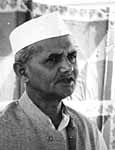

 |  |
 Nehruís death in May 1964 provided a test of the strength of the Indian political system. There were two main contenders for the leadership of the Congress parliamentary party and therefore for the prime ministerís job, Morarji Desai and Lal Bahadur Shastri. Desai was senior and more experienced, a sound administrator and scrupulously honest. But he was rigid and inflexible in outlook and had the reputation of being self-righteous, arrogant, intolerant and a right-winger. Moreover, he was quite unpopular with a large section of the party. Shastri was mild, tactful and malleable, highly respected and known to be personally incorruptible. Nehruís death in May 1964 provided a test of the strength of the Indian political system. There were two main contenders for the leadership of the Congress parliamentary party and therefore for the prime ministerís job, Morarji Desai and Lal Bahadur Shastri. Desai was senior and more experienced, a sound administrator and scrupulously honest. But he was rigid and inflexible in outlook and had the reputation of being self-righteous, arrogant, intolerant and a right-winger. Moreover, he was quite unpopular with a large section of the party. Shastri was mild, tactful and malleable, highly respected and known to be personally incorruptible.The succession occurred under the direction of a group of Congress leaders who came to be collectively known as the Syndicate. The group, formed in 1963, consisted of K. Kamaraj, the Congress president, and regional party bosses, Atulya Ghosh of Bengal, S.K. Patil of Bombay, N. Sanjeeva Reddy of Andhra Pradesh, and S. Nijalingappa of Mysore (Karnataka). Desai was utterly unacceptable to them. They favoured Shastri because, in addition to his other qualities, he had wider acceptability in the party and which would keep the party united. Kamaraj tried to ascertain the candidate around whom there would be wider consensus among the party MPs and announced that Shastri was more generally acceptable. Desai accepted it and retired from the race in a dignified manner. Shastri, elected unopposed, as the parliamentary leader by the party MPs, was sworn in as prime minister on 2 June 1964, i.e., within a week of Nehru's death. Accepting the limited character of his political mandate, Shastri did not make any major changes in Nehru's Cabinet, except for persuading Indira Gandhi, Nehruís daughter, to join it as Minister of Information and Broadcasting. Under him, the cabinet ministers functioned more autonomously. He also did not interfere in party affairs or with the working of the state governments. On the whole, he kept a low political profile except towards the end of his administration. The problem of the official language of Hindi versus English, flared up in early 1965, but the central government failed to handle it effectively and allowed the situation to deteriorate. The problem was, however, finally resolved in early 1966. The demands for Punjabi Suba (state) and Goa's merger with Maharashtra were also allowed to simmer. |
Copyright ©2000 indiansaga.info. All rights reserved.
By using this service, you accept that you won't copy or use the data given in this website for any commercial purpose.
The material on indiansaga.info is for informational & educational purpose only.
This site is best viewed at 800 X 600 picture resolution.